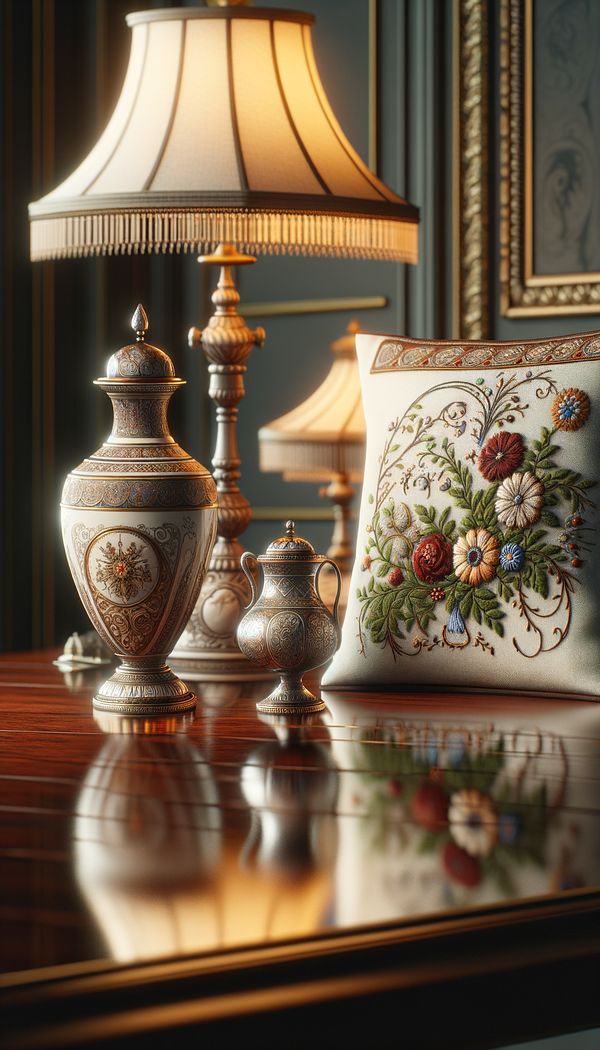What is Decorative Arts?
Decorative arts is a term that encompasses a wide range of arts and crafts designed to embellish interior spaces and objects.
Description
Decorative arts refers to the design and manufacture of aesthetically pleasing objects that serve a practical purpose within interior spaces. Unlike fine arts, which include painting and sculpture created purely for aesthetic appreciation, decorative arts bridge the gap between form and function. This field includes a variety of disciplines such as ceramics, glassware, jewelry, furniture, textiles, metalwork, and woodwork, among others.
The focus in decorative arts is on the design and craftsmanship of items that not only look beautiful but are also utilitarian. Whether it's an intricately designed rug that adds warmth and texture to a room, a hand-crafted ceramic vase that serves as the centerpiece of a dining table, or an elegantly designed piece of furniture that combines comfort with artistry, decorative arts enhance the visual appeal and functionality of living spaces.
Decorative arts have a long history, dating back to ancient civilizations where art and design were integrated into everyday objects. Over time, it has been influenced by various historical periods and movements, evolving with changes in taste, technology, and social norms. Today, decorative arts are celebrated for their fusion of traditional craftsmanship with contemporary design, making them a key element in expressive and personalized interiors.
Usage
Decorative arts can be seen in various interior settings, from residential homes to public buildings and corporate offices. Examples include hand-painted ceramic dishes in a kitchen, decorative metalwork on furniture and lighting fixtures, embroidered cushions, and tapestries that add color and texture to living spaces, or intricate glassware displayed in cabinets.
FAQs
-
How do decorative arts differ from fine arts?
Decorative arts are intended to be both beautiful and functional, serving a practical purpose in everyday life, whereas fine arts, such as painting and sculpture, are created for aesthetic contemplation and do not have a utilitarian function.
-
What are some common materials used in decorative arts?
Common materials include ceramics, glass, metal, wood, textiles, and leather, among others, each chosen for their unique properties and the specific aesthetic they bring to an object or space.
-
Can decorative arts include technological elements?
Yes, modern decorative arts often incorporate technological elements, such as LED lighting in decorative objects, to enhance both the utility and aesthetic appeal of a piece.
Practical Application
To incorporate decorative arts into your space, consider the functionality as well as the aesthetic appeal of each object. Choose pieces that reflect your personal style and complement the overall design theme of your space. Mixing traditional and contemporary decorative art can add depth and interest to your interiors.
-
Furniture Types599 articles
-
Lighting111 articles
-
Decorative Objects240 articles
-
Historical Periods & Movements150 articles
-
Textiles & Upholstery252 articles
-
DecalA decal is a design prepared on a special paper for durable transfer on to another surface such as glass, metal, or ceramic.
-
Crinoline StretcherA crinoline stretcher is a type of support structure used in furniture design.
-
American OrientalAmerican Oriental is a design style that merges traditional American design elements with Oriental influences.
-
BandingBanding refers to the decorative detail created by applying strips of material to the edges or borders of furniture, textiles, or architectural features.
-
ChenilleChenille is a soft, fuzzy fabric known for its luxurious texture.
